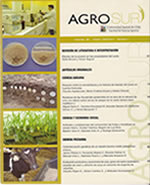Leucine retention by the clay-sized mineral fraction. An indicator of C storage
Main Article Content
Abstract
The chemical interactions between soil clay-sized mineral fractions and soluble organic compounds are mainly the result of soil sorption mechanisms into reactive sites. The ability of clay-size fractions from different Chilean soil groups to protect leucine from microbial decay was used as an index of the retention of soluble organic matter by soil mineral fractions. The reactivity of clay-sized mineral fractions was determined by extractable Al in ammonium acetate 1M, pH 4.8; acid ammonium oxalate 0.2 M; sodium pyrophosphate 0.1 M and pH levels in NaF. Leucine retention provided by the clay-sized mineral fraction was estimated by determining the amount of leucine remaining after a 24 h period of incubation post-application of leucine to soil mineral fractions under controlled conditions. The slope of non-linear regression (ratio between added versus recovered) reflects the different chemical protection capacities of the materials evaluated, where b values were 0.001, 0.021, 0.043, 0.124, 0.128 and 0.259 for quartz sand, smectite, kaolinite, halloysite, volcanic-glass and allophane, respectively. We found that the leucine retention index was related to the clay-sized reactive fraction for all the soil groups evaluated (R2 > 0.75). Thus, within the range used (up to 1480 mg kg-1 of leucine applied), the recovery was related to the amount of aluminium extracted with ammonium acetate 1M (R2 = 0.96). Clay-sized mineral fractions with greater reactivity, due to their dominant colloid fraction (clay-sized mineral fractions plus residual SOC), expressed bigger leucine protection to microbial decay.

